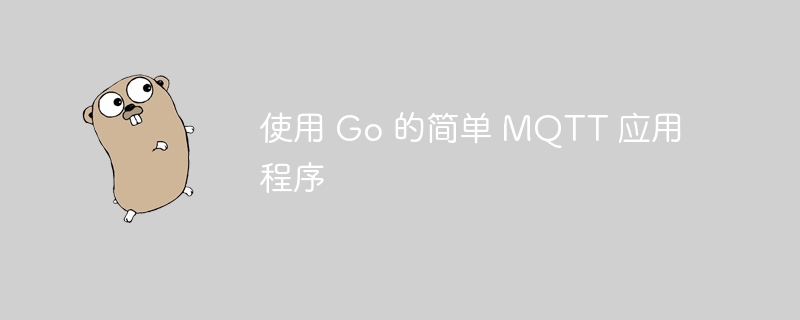使用 Go 的简单 MQTT 应用程序
来源:dev.to
时间:2024-09-20 21:25:13 336浏览 收藏
积累知识,胜过积蓄金银!毕竟在Golang开发的过程中,会遇到各种各样的问题,往往都是一些细节知识点还没有掌握好而导致的,因此基础知识点的积累是很重要的。下面本文《使用 Go 的简单 MQTT 应用程序》,就带大家讲解一下知识点,若是你对本文感兴趣,或者是想搞懂其中某个知识点,就请你继续往下看吧~

物联网设备有望改变我们与周围世界互动的方式。支持物联网的设备广泛应用于汽车、农业和许多其他行业。从所有这些设备检索数据不需要付出巨大的努力,这也不需要 mqtt。
mqtt 是物联网消息传递的标准。它的开发始于 90 年代末,并且有一个已被许多人采用的正式规范。 mqtt 提供了一种简单、轻量级的发布/订阅消息协议,使其易于在设备上实现并易于集成到大型系统中。
mqtt 通过使用代理来工作。代理位于物联网设备和使用设备数据的任何应用程序之间。在 mqtt 世界中,设备和应用程序都被视为“客户端”。
如果设备需要向世界发送数据,它就像 mqtt 客户端一样,创建与代理的连接,并将其数据发布到给定主题。 mqtt 主题是代理如何路由数据的方式。当应用程序想要从给定设备接收数据时,它会创建与代理的连接,然后订阅给定设备发布的主题。
为了进行演示,我将展示一个用于发布到 mqtt 代理的简单 go 应用程序。这只是模拟从物联网设备发送消息。 _(请注意,此 go 应用程序将在支持 golang 的嵌入式设备(例如 raspberry pi)上正常运行)_
要运行此示例,您需要查看我之前的文章,基本的 mqtt docker 部署,其中包括一个用于运行 mqtt 代理的 dockerfile。
package main
import (
"fmt"
"math/rand"
"time"
mqtt "github.com/eclipse/paho.mqtt.golang"
)
const (
broker = "tcp://localhost:1883"
clientid = "go-mqtt-client"
topic = "iot-messages"
)
var connecthandler mqtt.onconnecthandler = func(client mqtt.client) {
fmt.println("connected to mqtt broker")
}
var connectlosthandler mqtt.connectionlosthandler = func(client mqtt.client, err error) {
fmt.printf("connection lost: %v", err)
}
func main() {
opts := mqtt.newclientoptions()
opts.addbroker(broker)
opts.setclientid(clientid)
opts.onconnect = connecthandler
opts.onconnectionlost = connectlosthandler
client := mqtt.newclient(opts)
if token := client.connect(); token.wait() && token.error() != nil {
panic(token.error())
}
for {
message := generaterandommessage()
token := client.publish(topic, 0, false, message)
token.wait()
fmt.printf("published message: %s\n", message)
time.sleep(1 * time.second)
}
}
func generaterandommessage() string {
messages := []string{
"hello, world!",
"greetings from go!",
"mqtt is awesome!",
"random message incoming!",
"go is fun!",
}
return messages[rand.intn(len(messages))]
}
func init() {
rand.new(rand.newsource(time.now().unixnano()))
}
没什么大不了的,尽管我们可以让它对失败更加稳健。
应用程序创建一个新连接,指定代理 url 和代理将用来识别它的客户端 id。
请注意,发布消息非常简单,只需指定主题、qos、保留标志和消息本身即可。
消息可以是字符串、字节数组或缓冲区。对于qos,我们将其设置为0,这意味着“最多一次”,即不保证传送。
保留标志告诉代理是否将最后一条消息存储到给定主题。如果消息被“保留”,当新客户端订阅给定主题时,最新保留的消息将立即发送给它。在此示例中,我们没有使用该功能。
请注意,此发布者应用程序的源代码可以在此页面底部的链接中找到。
现在让我们看看订阅者端。
package main
import (
"context"
"fmt"
mqtt "github.com/eclipse/paho.mqtt.golang"
"os"
"os/signal"
"sync"
"syscall"
)
const (
broker = "tcp://localhost:1883"
clientID = "go-mqtt-subscriber"
topic = "iot-messages"
)
var mqttMsgChan = make(chan mqtt.Message)
var messagePubHandler mqtt.MessageHandler = func(client mqtt.Client, msg mqtt.Message) {
mqttMsgChan <- msg
}
func processMsg(ctx context.Context, input <-chan mqtt.Message) chan mqtt.Message {
out := make(chan mqtt.Message)
go func() {
defer close(out)
for {
select {
case msg, ok := <-input:
if !ok {
return
}
fmt.Printf("Received message: %s from topic: %s\n", msg.Payload(), msg.Topic())
out <- msg
case <-ctx.Done():
return
}
}
}()
return out
}
var connectHandler mqtt.OnConnectHandler = func(client mqtt.Client) {
fmt.Println("Connected to MQTT Broker")
}
var connectLostHandler mqtt.ConnectionLostHandler = func(client mqtt.Client, err error) {
fmt.Printf("Connection lost: %v", err)
}
func main() {
opts := mqtt.NewClientOptions()
opts.AddBroker(broker)
opts.SetClientID(clientID)
opts.SetDefaultPublishHandler(messagePubHandler)
opts.OnConnect = connectHandler
opts.OnConnectionLost = connectLostHandler
client := mqtt.NewClient(opts)
if token := client.Connect(); token.Wait() && token.Error() != nil {
panic(token.Error())
}
ctx, cancel := context.WithCancel(context.Background())
var wg sync.WaitGroup
wg.Add(1)
go func() {
defer wg.Done()
finalChan := processMsg(ctx, mqttMsgChan)
for range finalChan {
// just consuming these for now
}
}()
// Subscribe to the topic
token := client.Subscribe(topic, 1, nil)
token.Wait()
fmt.Printf("Subscribed to topic: %s\n", topic)
// Wait for interrupt signal to gracefully shutdown the subscriber
sigChan := make(chan os.Signal, 1)
signal.Notify(sigChan, os.Interrupt, syscall.SIGTERM)
<-sigChan
// Cancel the context to signal the goroutine to stop
cancel()
// Unsubscribe and disconnect
fmt.Println("Unsubscribing and disconnecting...")
client.Unsubscribe(topic)
client.Disconnect(250)
// Wait for the goroutine to finish
wg.Wait()
fmt.Println("Goroutine terminated, exiting...")
}
与发布端类似,应用程序使用代理 url 及其客户端 id 设置客户端。我们设置一个默认处理程序来处理传入的消息;但应用程序订阅的每个主题可能都有不同的主题。
您可以看到此示例包含一些同步来处理终止程序。
还有一个处理消息的管道。虽然对于本例来说不是必需的;当处理大量消息时它会派上用场。
就是这样。从我之前的文章中启动 mqtt 代理或使用另一个代理。您可以在这里找到一个免费的测试经纪人。
在不同的终端中启动发布者和订阅者。您应该会在订阅者控制台中看到收到的消息。
您可以在这里找到发布者代码和订阅者代码
你觉得怎么样?您将如何使出版商变得更加强大?同步和管道可以简化吗?请在下面的评论中告诉我您的想法。
今天带大家了解了的相关知识,希望对你有所帮助;关于Golang的技术知识我们会一点点深入介绍,欢迎大家关注golang学习网公众号,一起学习编程~
-
505 收藏
-
503 收藏
-
502 收藏
-
502 收藏
-
502 收藏
-
215 收藏
-
352 收藏
-
448 收藏
-
311 收藏
-
343 收藏
-
139 收藏
-
146 收藏
-
219 收藏
-
282 收藏
-
179 收藏
-
359 收藏
-
377 收藏
-

- 前端进阶之JavaScript设计模式
- 设计模式是开发人员在软件开发过程中面临一般问题时的解决方案,代表了最佳的实践。本课程的主打内容包括JS常见设计模式以及具体应用场景,打造一站式知识长龙服务,适合有JS基础的同学学习。
- 立即学习 543次学习
-

- GO语言核心编程课程
- 本课程采用真实案例,全面具体可落地,从理论到实践,一步一步将GO核心编程技术、编程思想、底层实现融会贯通,使学习者贴近时代脉搏,做IT互联网时代的弄潮儿。
- 立即学习 516次学习
-

- 简单聊聊mysql8与网络通信
- 如有问题加微信:Le-studyg;在课程中,我们将首先介绍MySQL8的新特性,包括性能优化、安全增强、新数据类型等,帮助学生快速熟悉MySQL8的最新功能。接着,我们将深入解析MySQL的网络通信机制,包括协议、连接管理、数据传输等,让
- 立即学习 500次学习
-

- JavaScript正则表达式基础与实战
- 在任何一门编程语言中,正则表达式,都是一项重要的知识,它提供了高效的字符串匹配与捕获机制,可以极大的简化程序设计。
- 立即学习 487次学习
-

- 从零制作响应式网站—Grid布局
- 本系列教程将展示从零制作一个假想的网络科技公司官网,分为导航,轮播,关于我们,成功案例,服务流程,团队介绍,数据部分,公司动态,底部信息等内容区块。网站整体采用CSSGrid布局,支持响应式,有流畅过渡和展现动画。
- 立即学习 485次学习
